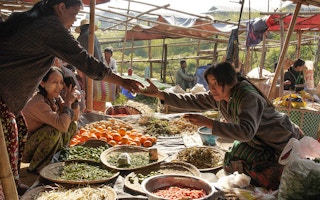About 150 million people risk a significant loss of protein if carbon dioxide emissions continue to rise, leaving children in the worst-affected countries more vulnerable to death and disease, according to new research.
Today, 76 per cent of the world’s population gets most of its protein from plants, but higher CO2 emissions will reduce the amount of protein - as well as iron and zinc - in a range of staple crops, said researchers at the Harvard T.H. Chan School of Public Health.
Eighteen countries, including India, may lose more than 5 per cent of their dietary protein by 2050 as a result of crops such as rice, wheat and barley losing their nutritional value.
“
Thought must be given to reducing vulnerability … through supporting more diverse and nutritious diets, enriching the nutritional content of staple crops, and breeding crops less sensitive to these CO2 effects.
Samuel Myers, senior research scientist, Harvard T.H. Chan School of Public Health
Lack of protein contributes to children being underweight and short, and leaves them more open to disease and death.
“Thought must be given to reducing vulnerability … through supporting more diverse and nutritious diets, enriching the nutritional content of staple crops, and breeding crops less sensitive to these CO2 effects,” said senior research scientist Samuel Myers.
“And, of course, we need to dramatically reduce global CO2 emissions as quickly as possible,” added Myers, who is co-author of the paper, which was published on Wednesday in Environmental Health Perspectives, a monthly peer-reviewed journal.
The effects of CO2 on protein levels are less pronounced in maize, sorghum and beans, the authors said.
High CO2 levels in the atmosphere are also likely to cut the amount of iron in plants, Harvard researchers said in a companion study published in GeoHealth scientific journal.
Those most vulnerable to a loss of iron in their staple crops include 354 million children under five and more than 1 billion women of childbearing age, mainly in South Asia and north Africa, the researchers said.
They live in countries already experiencing high rates of anaemia and whose crops are expected to lose more than 3.8 per cent of dietary iron as a result of the CO2 effect.
Lack of iron affects people’s ability to work, and leads to higher death rates during pregnancy and childbirth, and increased health risks for children.
“Because these changes will be gradual and largely imperceptible, it will require ongoing monitoring of the nutrient content of their crops … to evaluate when and how to most effectively intervene if necessary,” the researchers said.
This story was published with permission from Thomson Reuters Foundation, the charitable arm of Thomson Reuters, that covers humanitarian news, climate change, resilience, women’s rights, trafficking and property rights. Visit http://news.trust.org/climate










